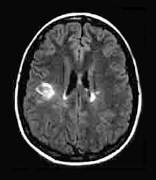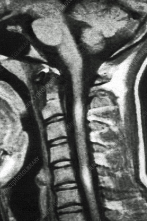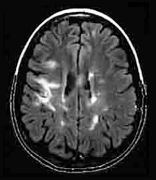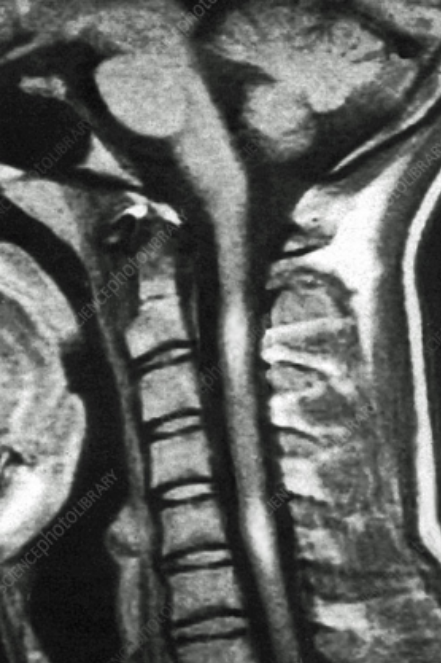
IDENTIFYING PATIENT TRANSITIONS IN MULTIPLE SCLEROSIS
Jennifer,* 40 Years
Diagnosed with RRMS in 2002
A stay-at-home mom with 2 children, she has had multiple relapses in the past year. Jennifer has switched DMTs twice in the past 5 years.
What is Jennifer's current Diagnosis?
Patient Notes*
Expanded Disability Status Scale (EDSS)2

Sustained progression of disease is predicted by a minimum score of 4,3 and an increase in EDSS score of at least one point (for scores ≤5.5), measured over two time points, at least three months apart.4
Patient Notes*
Relapses
-
Four relapses in the past year
-
Unresolved symptoms since most recent relapse:
-
Double vision
-
Balance issues
-
Problems picking things up (fine motor skills)
-
Leg pain
-
Increasing fatigue
-
Current Symptoms
-
Double vision
-
Balance issues
-
Numbness and tingling in the fingers
-
Leg pain
-
Increasing fatigue
-
Difficulty with processing information
Functioning
Symptoms have impacted Jennifer's ability to care
for her children and other daily activities
As a physical sensation it reminds me of falling into quicksand/a swamp - it's a viscous, heavy, pulling feeling, but if I try to fight it, it hurts like hell and robs me of breath. As a sound, it's like a muted background noise of violins, scratching away, that seem to be ever increasing in speed and out of sync - while the outside world seems dampened and fading.12**
**Actual patient testimonial.
Patient History*
Clinical data6 from 6 months ago
Evoked potentials
- Abnormal (prolonged) upper limb somatosensory evoked potentials (SSEPs)
Symbol Digit Modalities Test13
54.7
Modified Fatigue Impact Scale9,10
44
Total Score
Brain MRI
Several demyelinated lesions
Permission granted by Springer International Publishing11 |
Spinal MRI
Two cervical lesions
Permission granted by Springer International Publishing11 |
Current Test Results*
Current results
Evoked potentials
- Abnormal (prolonged) lower limb somatosensory evoked potentials (SSEPs)
Symbol Digit Modalities Test13
 50.7
50.7
Modified Fatigue Impact Scale9,10
 44
44
Total Score
Brain MRI
Lesions have expanded in size and several new lesions are visible
Permission granted by Springer International Publishing11 |
Spinal MRI
Same multiple cervical T2 lesion; no new lesion present
Permission granted by Springer International Publishing11 |
*Not a real patient.
DMT, disease modifying therapy; EDSS, Expanded Disability Status Scale; MRI, magnetic resonance imaging; RRMS, relapsing-remitting multiple sclerosis; SSEP, somatosensory evoked potential.
- Burtchell J, Fetty K, Miller K, Minden K, et al. Two sides to every story: Perspectives from four patients and a healthcare professional on multiple sclerosis disease progression. Neurol Ther. 2019;8:185-205.
- Kurtzke JF. Rating neurologic impairment in multiple sclerosis: An expanded disability status scale (EDSS). Neurology. 1983;33(11):1444-1452.
- Lorscheider J, Buzzard K, Jokubaitis V, et al. Defining secondary progressive multiple sclerosis. Brain. 2016;139(Pt 9):2395-2405.
- Kalincik T, Cutter G, Spelman T, et al. Defining reliable disability outcomes in multiple sclerosis. Brain. 2015;138(Pt 11):3287-3298.
- Luzzio C. Multiple sclerosis. Accessed March 13, 2020. https://emedicine.medscape.com/
article/1146199 - Tur C, Moccia M, Markhof F, et al. Assessing treatment outcomes in multiple sclerosis trials and in the clinical setting. Nat Rev Neurol.
2018;14(2):75-93. - Fischer JS, Jak AJ, Kniker JE, et al. Multiple Sclerosis Functional Composite (MSFC). Accessed March 29, 2020. Administration and Scoring Manual. https://www.nationalmssociety.org/
NationalMSSociety/media/MSNationalFiles/
Brochures/10-2-3-31-MSFC_Manual_and_Forms.pdf - Phan-Ba R, Pace A, Calay P, et al. Comparison of the timed 25-foot and the 100-meter walk as performance measures in multiple sclerosis. Neurorehabil Neural Repair. 2011;25(7):672-679.
- Ritvo PG, Fischer JS, Miller DM, et al. Multiple Sclerosis Quality of Life Inventory: A User’s Manual. National Multiple Sclerosis Society. New York, NY:1997;47-49. Accessed March 27, 2020. https://www.nationalmssociety.org/For- Professionals/Researchers/Resources-for- Researchers/Clinical-Study-Measures/Multiple- Sclerosis-Quality-of-Life-Inventory-(MSQL
- Hadjimichael O, Vollmer T, Oleen-Burkey M. Fatigue characteristics in multiple sclerosis: The North American Research Committee on Multiple Sclerosis (NARCOMS) survey. Health Qual Life Outcomes. 2008;6:100.
- Eckstein C. Established relapsing-remitting multiple sclerosis. In: Giacomini PS, ed. Case Studies in Multiple Sclerosis. Springer International Publishing; 2017:35-57.
- Multiple Sclerosis Trust. Describing fatigue to others. Accessed March 6, 2020. https:// www.mstrust.org.uk/news/views-and-comments/ describing-fatigue-others
- Benedict RHB, DeLuca J, Phillips G, et al. Validity of the Symbol Digit Modalities Test as a cognition performance outcome measure for multiple sclerosis. Mult Scler J. 2017;23(5):721-733.
- Zivadinov R, Bakshi R. Role of MRI in multiple sclerosis II: Brain and spinal cord atrophy. Front Biosci. 2004;9:647-664.
- Science Photo Library. Accessed March 30, 2020. https:www.sciencephoto.com/media/779202




